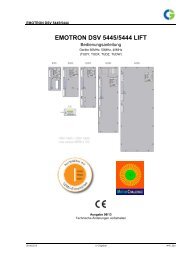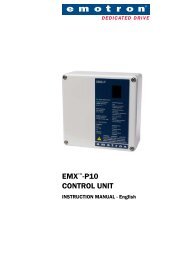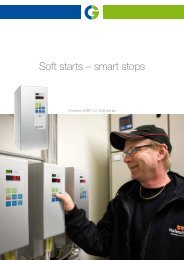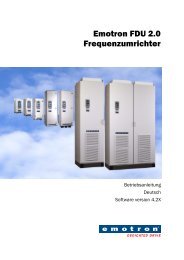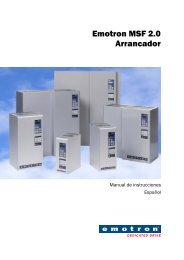Emotron FDU/VFX 2.0 AC drive
Emotron FDU/VFX 2.0 AC drive
Emotron FDU/VFX 2.0 AC drive
Create successful ePaper yourself
Turn your PDF publications into a flip-book with our unique Google optimized e-Paper software.
<strong>Emotron</strong> <strong>FDU</strong>/<strong>VFX</strong> <strong>2.0</strong><br />
<strong>AC</strong> <strong>drive</strong><br />
Option Safe Stop<br />
(STO – Safe Torque Off)<br />
Technical description<br />
English
<strong>Emotron</strong> <strong>FDU</strong>/<strong>VFX</strong> <strong>2.0</strong> <strong>AC</strong> <strong>drive</strong><br />
Option Safe Stop<br />
(STO – Safe Torque Off)<br />
Technical description<br />
English<br />
Document number: 01-5921-01<br />
Edition: r0<br />
Date of release: 15 May 2013<br />
© Copyright CG Drives & Automation Sweden AB 2011 - 2013<br />
CG Drives & Automation retains the right to make changes to product<br />
specifications without prior notice. This document must not be<br />
reproduced without the explicit permission of CG Drives & Automation<br />
Sweden AB.
Contents<br />
1. General ........................................................... 3<br />
2. Safe stop option (STO – Safe Torque Off) .... 6<br />
3. Explanation .................................................... 7<br />
4. Possibilities for safe stops STO .................... 7<br />
5. Disconnecting time ....................................... 7<br />
6. Technical description of safe stop option - STO 8<br />
7. Recommended circuit arrangements .......... 9<br />
8. Certificate .................................................... 20<br />
CG Drives & Automation 01-5921-01r0 1
2 CG Drives & Automation 01-5921-01r0
1. General<br />
Increasing automation is making it more and more<br />
important to protect persons from dangerous movements.<br />
Functional safety defines the measures necessary, by<br />
electrical or electronic means, to minimise or eliminate<br />
dangers due to malfunctions.<br />
In normal operation, safety devices prevent access of persons<br />
to hazard zones. For certain procedures such as setting up<br />
operations, persons must enter hazard zones. In these<br />
situations, machine operators must be protected by means of<br />
specific safety provisions within the <strong>drive</strong> and control<br />
system.<br />
Integrated safety systems offer the prerequisites for optimal<br />
realisation of protective functions on the control and <strong>drive</strong><br />
side.<br />
This reduces planning and installation complexity. The use<br />
of integrated safety systems increases the machine<br />
functionality and availability compared to conventional<br />
safety systems.<br />
1.1 Integrated safety systems<br />
<strong>Emotron</strong> <strong>FDU</strong> and <strong>VFX</strong> series variable speed <strong>drive</strong>s Version<br />
<strong>2.0</strong>, sizes B, C, D, E and larger are available with a safe stop<br />
option (STO – Safe Torque Off).<br />
'Integrated safety systems' are application-related safety<br />
functions that can be used for the protection of persons at<br />
machines.<br />
Motion functions are still controlled by variable speed<br />
<strong>drive</strong>s. This option ensures that limiting values are reliably<br />
maintained and provides safe inputs and outputs. With a<br />
safe stop option, the safety modules initiate control<br />
functions directly in the variable speed <strong>drive</strong> as defined in<br />
EN 60204-1.<br />
1.2 The replacement of<br />
EN 954-1<br />
Up to now, machine builders have had to provide<br />
verification of compliance with the general safety<br />
requirements according to EN 954-1 (Safety-related parts of<br />
control systems – Part 1: General principles for design) in<br />
accordance with European Machinery Directives. This<br />
standard requires risk analysis with the resulting safety<br />
categories (B,1,2,3,4), where B stands for low to virtually no<br />
safety and 4 for high safety. Machine manufacturers select<br />
safety devices for their particular machines based on the<br />
resulting safety categories.<br />
EN 954-1 was replaced because it did not adequately<br />
consider programmable electronic systems and took no<br />
account of the dynamic behaviour (e.g. test intervals,<br />
longevity) and failure probability of the specific<br />
components. The successor standards EN 13849-1 (Safety<br />
of machinery – Safety-related parts of control systems -<br />
Part 1: General principles for design) and EN 62061 (Safety<br />
of machinery – Functional safety of safety-related electrical,<br />
electronic and programmable electronic control systems)<br />
provide a remedy.<br />
EN ISO 13849-1 includes the qualitative approach of EN<br />
954-1 and also provides quantitative safety function<br />
considerations. For the classification of the various safety<br />
performance levels, EN ISO 13849-1 defines Performance<br />
Levels (PL) based on the corresponding specific categories.<br />
The five performance levels (a, b, c, d, e) indicate the<br />
different average probability values of a dangerous failure per<br />
hour.<br />
1.2.1Performance Level (PL)<br />
according to EN ISO 13849-1<br />
Average probability of a dangerous failure per hour (1/h)<br />
Performance<br />
Level (PL)<br />
a > 10 -5 to < 10 -4<br />
b > 3 x 10 -6 to < 10 -5<br />
c > 10 -6 to < 3 x 10 -6<br />
d > 10 -7 to < 10 -6<br />
e > 10 -8 to < 10 -7<br />
Average probability of a dangerous<br />
failure per hour (1/h)<br />
Determination of required performance<br />
levels (PLr)<br />
To determine the required performance level for each safety<br />
function of a safety-related control system, a risk assessment<br />
must be carried out and documented.<br />
The informative Appendix A of the standard specifies a<br />
qualitative procedure for risk assessment and determination<br />
of the required performance level. The same risk parameters<br />
CG Drives & Automation 01-5921-01r0 General 3
are used for the purpose of risk assessment as those defined<br />
in EN 954-1.<br />
Risk parameters:<br />
S Severity of injury<br />
S1 Slight (normally reversible injury)<br />
S2 Serious (normally irreversible injury or<br />
death)<br />
F Frequency and/or exposure to hazard<br />
F1 Seldom-to-less-often and/or exposure<br />
time is short<br />
F2 Frequent-to-continuous and/or exposure<br />
time is long<br />
P Possibility of avoiding hazard or<br />
limiting harm<br />
P1 Possible under specific conditions<br />
P2 Scarcely possible<br />
Risk graph for determination of the required performance<br />
level for each safety function:<br />
Start<br />
Determination of achieved performance level<br />
For determination of the performance level of components/<br />
devices, the following safety parameters must be taken into<br />
consideration:<br />
Safety<br />
parameters<br />
defined in<br />
EN ISO 13849-1<br />
Cat.<br />
Meaning<br />
Category (B, 1, 2, 3, 4), structural design<br />
as a basis for achieving a specific<br />
performance level<br />
PL Performance level (a, b, c, d, e)<br />
MTTF d<br />
B 10d<br />
DC<br />
CCF<br />
T M<br />
Mean time to dangerous failure<br />
Number of cycles until 10 % of the<br />
components fail dangerously (for<br />
pneumatic and electromechanical<br />
components)<br />
Diagnostic coverage<br />
Common cause failure<br />
Mission time<br />
Further parameters to be considered are operating factors<br />
such as the demand rate and/or test rate for the safety<br />
function which can also have an influence on the resulting<br />
performance level.<br />
Fig. 1 Risk graph (source: EN ISO 13849-1)<br />
Legend:<br />
Start Starting point for evaluation of safety<br />
function’s contribution to risk reduction<br />
L Low contribution to risk reduction<br />
H High contribution to risk reduction<br />
PLr Required Performance Level<br />
4 General CG Drives & Automation 01-5921-01r0
1.3 Risk analysis<br />
This documentation can only indicate the necessity of a risk<br />
analysis. Users of integrated safety systems must familiarise<br />
themselves with the relevant standards and legislation.<br />
Before a machine can be marketed, machine manufacturers<br />
must perform a risk analysis in accordance with the<br />
Machinery Directive so as to determine the risk associated<br />
with the use of the machine. To achieve the highest level of<br />
safety, the Machinery Directive defines three basic<br />
principles:<br />
• elimination or minimisation of risks due to the<br />
design;<br />
• taking necessary protective measures against risks<br />
that cannot be eliminated;<br />
• documentation of the residual risks and information<br />
of users about these risks.<br />
1.3.1Safe Stop Parameter<br />
As determined by TÜV testing in accordance with ISO/<br />
EN 13849-1:2006<br />
(see TÜV certificate, and based on the associated<br />
technical report no. 09 799 555179-001)<br />
Requirements according to category 3 and<br />
Performance level d:<br />
PFHDssD =1.70 .10-9 rev per hour<br />
DC = average (86%)<br />
HFT = 1 ( Enable input and Safe Stop board)<br />
MTTFd = 380.52 years (high)<br />
Outcome: SIL3, SILCL3 and Performance Level d<br />
Requirements according to category 4 and<br />
Performance level e:<br />
PFHDssD =1.70 .10-9 rev per hour<br />
DC =<br />
HFT =<br />
MTTFd =<br />
high (90% - indirect monitoring Safe<br />
Stop path, direct monitoring contactor<br />
contacts)<br />
1 ( pilot contactor and Safe Stop<br />
board)<br />
380.52 years (high)<br />
Outcome: SIL3, SILCL3 and Performance Level e<br />
The following parameters were assumed and applied in<br />
the MTTFd calculation-:<br />
B10d =2,000,000 (contactor under normal loading)<br />
Days in operation per year Dop =365 d/a<br />
Hours of operation per day Hop =24 h/d<br />
Cycle time tcycle =600s<br />
The MTTFd value must be recalculated in the event of<br />
different values for Dop, Hop and tcycle.<br />
Abbreviations<br />
Abbreviation<br />
PFHDssD<br />
DC<br />
HFT<br />
Dop<br />
Hop<br />
tcycle<br />
SIL<br />
Meaning<br />
Average probability of a dangerous failure<br />
per hour<br />
Diagnostic coverage<br />
Hardware Fault Tolerance<br />
Days of operation per year<br />
Hours of operation per year<br />
Cycle time<br />
Safety Integrity Level<br />
1.4 Stop categories and<br />
emergency stop<br />
The following information is important if emergency stop<br />
circuits are used or needed in the installation where a<br />
variable speed <strong>drive</strong> is used. EN 60204-1 defines 3 stop<br />
categories:<br />
Category 0: Uncontrolled STOP<br />
Stopping by switching off the supply voltage. A mechanical<br />
stop must be activated. This STOP may not be<br />
implemented with the help of a variable speed <strong>drive</strong> or its<br />
input or output signals.<br />
Category 1: Controlled STOP<br />
Stopping until the motor has come to a standstill, after<br />
which the mains supply is switched off. This STOP may not<br />
be implemented with the help of a variable speed <strong>drive</strong> or its<br />
input or output signals.<br />
Category 2: Controlled STOP<br />
Stopping while the supply voltage is connected. This STOP<br />
can be implemented with each variable speed <strong>drive</strong> STOP<br />
command.<br />
WARNING!<br />
The standard specifies that all machines<br />
must be provided with a category 0 stop. If<br />
the application prevents this from being<br />
implemented, this must be explicitly stated.<br />
Furthermore, every machine must be provided with an<br />
emergency stop function. This function must ensure<br />
that any dangerous voltage on the machine is disconnected<br />
as quickly as possible without the risk of<br />
further danger. In such an emergency stop situation, a<br />
category 0 or 1 stop may be used; the choice of<br />
category depends on the possible risks to the machine.<br />
CG Drives & Automation 01-5921-01r0 General 5
2. Safe stop option (STO – Safe Torque Off)<br />
In conformity with the machinery standard and certified by<br />
an approved body, this safety function can allow:<br />
• easy machine certification<br />
• omission of electromechanical redundance<br />
• reduction of wiring and installation complexity<br />
• space-saving control cabinet use<br />
Safe Stop<br />
Safe Stop<br />
Fig. 2<br />
Safe stop option for sizes B to D<br />
Fig. 3<br />
Safe stop option for size E and up<br />
6 Safe stop option (STO – Safe Torque Off) CG Drives & Automation 01-5921-01r0
3. Explanation<br />
The safe stop option prevents unintended starting of a<br />
motor and ensures the safety of the operator and machine.<br />
This is achieved in that the power supply to the <strong>drive</strong> is<br />
reliably interrupted. The <strong>drive</strong> must not be able to generate<br />
any torque and perform any dangerous movements.<br />
Zero-speed monitoring is unnecessary. Interruption of the<br />
power supply can, but does not have to take place with<br />
contacts.<br />
Where external forces prevail, additional measures such as<br />
mechanical brakes must be provided for safe stops to reliably<br />
prevent possible movements.<br />
<strong>Emotron</strong> <strong>FDU</strong> and <strong>VFX</strong> variable speed <strong>drive</strong>s are available<br />
with safe stop option which is realised by pulse blocking.<br />
This obviates the necessity of further contactors which<br />
increases the operational reliability and incurs no further<br />
costs. This allows variable speed <strong>drive</strong>s to be directly<br />
included without additional components in standard safety<br />
concepts where, for example, operating areas are protected<br />
with safety switches on protective devices or the devices are<br />
directly included in the emergency stop circuits.<br />
5. Disconnecting time<br />
The disconnecting time on initiating a safe stop is typically<br />
< 50 ms.<br />
4. Possibilities for safe<br />
stops STO<br />
Suitable measures for a safe stop are, for example:<br />
• contactor between power supply and <strong>drive</strong> system<br />
(mains contactor) or<br />
• contactor between power section and <strong>drive</strong> motor<br />
(motor contactor) or<br />
• blocking control pulses to the power semiconductor<br />
(pulse blocking).<br />
Fig. 4<br />
Disconnecting time<br />
Fig. 4 shows the measurement of the disconnecting time.<br />
Measurement was made with a FLUKE 196B Scopemeter.<br />
Channel A: Motor output terminals U and W directly on<br />
the variable speed <strong>drive</strong><br />
Channel B: EMERGENCY STOP relay terminals S11 and<br />
S12<br />
The circuit arrangement used is as shown in the example on<br />
page 15 (circuit arrangement according to standards<br />
EN 954-1, category 3 and IEC/EN 61508, capacity SIL2,<br />
stop category 1 according to standard IEC/EN 60204-1).<br />
CG Drives & Automation 01-5921-01r0 Explanation 7
6. Technical description of safe stop option - STO<br />
<strong>Emotron</strong> <strong>FDU</strong> and <strong>VFX</strong> variable speed <strong>drive</strong>s with safe stop<br />
option are supplied with the safety function jumpered. This<br />
makes commissioning without safe stop easily possible. To<br />
use this function, the jumpers must be removed from the<br />
terminal strip on the option board (jumper between<br />
terminals 1 and 6 and jumper between terminals 2 and 5).<br />
X1<br />
Pin<br />
Name Function Specification<br />
1 Inhibit + Inhibit <strong>drive</strong>r circuits<br />
2 Inhibit - of power conductors<br />
3<br />
4<br />
NO contact<br />
relay K2<br />
P contact<br />
relay K2<br />
Feedback:<br />
Confirmation of<br />
activated inhibit<br />
5 GND Supply ground<br />
6 + 24V DC<br />
Supply Voltage for<br />
operating inhibit<br />
input only<br />
DC 24V<br />
(20 - 30V)<br />
48V DC /<br />
30V <strong>AC</strong>/2A<br />
When the safety stop function is activated, this circuit<br />
arrangement ensures that the motor cannot start. This is<br />
achieved by the following actions:<br />
• The 24 V DC signal at the safe stop input (Inhibit+<br />
and Inhibit-) is interrupted.<br />
Safety relay K1 is de-energised.<br />
The supply voltage to the <strong>drive</strong>r circuits of the power<br />
is interrupted.<br />
This willinhibit the trigger pulses to the power<br />
conductors.<br />
• The trigger pulses from the control board are<br />
cancelled. The signal is monitored by the<br />
control board.<br />
To make sure that the safety relay K1 is de-energised, it<br />
should be externally monitored. For this purpose, the safe<br />
stop option board generates a feedback signal via a second<br />
safety relay that is energised when the supply voltage to the<br />
<strong>drive</strong>r circuits is shut down.<br />
Safe output K2 (terminals 3 and 4)<br />
Information can be output to a higher-level unit (e.g. safety<br />
PLC) or external operating elements (actuators) via the safe<br />
output on the option board. The feedback output is isolated<br />
and must be separately supplied with 24 V.<br />
When the safe stop input is active, the variable speed <strong>drive</strong><br />
display will show a blinking 'SST' symbol in section C<br />
(bottom left corner) of the display and the red warning/fault<br />
LED on the control panel will blink. To resume normal<br />
operation, the following steps have to be taken:<br />
• enable safe stop input (terminals 1 and 2)<br />
• Give a STOP signal to the VSD, according to the set<br />
Run/Stop Control in menu [215]<br />
• Give a new RUN command, according to the set<br />
Run/Stop Control in menu [215]<br />
WARNING!<br />
The safe stop function must never be used for<br />
electrical maintenance purposes. Before<br />
carrying out any electrical maintenance, the<br />
variable speed <strong>drive</strong> must always be disconnected<br />
from the power supply.<br />
8 Technical description of safe stop option - STO CG Drives & Automation 01-5921-01r0
7. Recommended circuit arrangements<br />
The standard specifies the use of a stop button with double<br />
contact (S1). The variable speed <strong>drive</strong> logic output signals<br />
cannot be regarded as safety-related signals.<br />
Recommended circuit arrangements are shown on the<br />
following pages as examples:<br />
Fig. 5, page 10<br />
This circuit arrangement is suitable for free coasting<br />
machines with short stopping times.<br />
When the emergency stop circuit is activated, the 'safe stop'<br />
safety function is activated.<br />
The connected motor coasts freely.<br />
Fig. 7, page 12<br />
Circuit arrangement according to standards EN 954-1,<br />
category 3 and IEC/EN 61508, capacity SIL2,<br />
stop category 1 according to standard IEC/EN 60204-1<br />
This circuit arrangement is suitable for free coasting<br />
machines with long stopping times (with strong moment of<br />
inertia or weak counter-torque).<br />
When the emergency stop circuit is activated, the variable<br />
speed <strong>drive</strong> causes the motor to coast controlled and the 'safe<br />
stop' safety function is activated with a delay corresponding<br />
to the coasting time.<br />
Fig. 9, page 14<br />
Circuit arrangement according to standards EN 954-1,<br />
category 3 and IEC/EN 61508, capacity SIL3,<br />
stop category 1 according to standard IEC/EN 60204-1<br />
This circuit arrangement is suitable for free coasting<br />
machines with long stopping times (with strong moment of<br />
inertia or weak counter-torque).<br />
When the emergency stop circuit is activated, the variable<br />
speed <strong>drive</strong> causes the motor to coast controlled and the 'safe<br />
stop' safety function is activated with a delay corresponding<br />
to the coasting time.<br />
Fig. 10, page 15<br />
Circuit arrangement according to standards EN 954-1,<br />
category 4 and IEC/EN 61508, capacity SIL3,<br />
stop category 0 according to standard IEC/EN 60204-<br />
1(only for sizes B, C, and D)<br />
This circuit arrangement is suitable for free coasting<br />
machines with short stopping times.<br />
When the emergency stop circuit is activated, the 'safe stop'<br />
safety function is activated and the power supply is<br />
disconnected via the power contactor.<br />
The connected motor coasts freely.<br />
Fig. 11, page 16<br />
Circuit arrangement according to standards EN 954-1,<br />
category 4 and IEC/EN 61508 capacity SIL3,<br />
stop category 2 according to standard IEC/EN 60204-1<br />
(only for sizes B, C and D)<br />
This circuit arrangement is suitable for free coasting<br />
machines with long stopping times (with strong moment of<br />
inertia or weak counter-torque).<br />
When the emergency stop circuit is activated, the variable<br />
speed <strong>drive</strong> causes the motor to coast controlled, the 'safe<br />
stop' safety function is activated with a delay corresponding<br />
to the coasting time and the power supply is disconnected<br />
via the power contactor.<br />
CG Drives & Automation 01-5921-01r0 Recommended circuit arrangements 9
0<br />
Aenderung<br />
Rev02<br />
0<br />
1<br />
2<br />
Einspeisung<br />
9Q1<br />
9F1<br />
9U1<br />
<strong>FDU</strong>/<strong>VFX</strong><br />
ab Vers.<strong>2.0</strong><br />
L1<br />
L2<br />
L3<br />
U<br />
V<br />
W<br />
PE<br />
9M1<br />
1.9/0V(24V)<br />
Datum<br />
13.04.12<br />
Datum<br />
Bearb.<br />
MS<br />
13.04.12<br />
Name<br />
Gepr.<br />
Norm<br />
13.04.12<br />
DIN Ursprung:<br />
3<br />
Ersatz fuer:<br />
4<br />
Sicherer Halt<br />
Ersatz durch:<br />
5<br />
5 6 7<br />
IEC/EN 61508<br />
Sicherheitskategorie 1<br />
Stoppkategorie 0<br />
8<br />
7 8<br />
=<br />
+<br />
Plottrahemen CG 1 vom 13.04.2012<br />
9<br />
2<br />
Bl.<br />
13 Bl.<br />
1<br />
Run<br />
Enable<br />
DI1<br />
8<br />
DI2<br />
9<br />
DI3<br />
10 DI4<br />
16<br />
DI5<br />
17 DI16<br />
18<br />
9<br />
K3<br />
.8<br />
DI17<br />
19 DI8<br />
22<br />
+24VDC<br />
11 com<br />
15<br />
OPTION SICHERER HALT<br />
Inhibit+<br />
Inhibit-<br />
Kontakt K2<br />
Kontakt K2<br />
GND<br />
+24VDC<br />
K1<br />
1<br />
1.9/24V<br />
K2<br />
2<br />
3<br />
4<br />
5<br />
6<br />
NOT<br />
AUS<br />
START<br />
STOP<br />
9<br />
K3<br />
.9<br />
.1<br />
24V/1.4<br />
9<br />
K3<br />
.8<br />
0V(24V)/1.0<br />
Fig. 5 IEC/EN 61508, safety category 1, stop category 0<br />
10 Recommended circuit arrangements CG Drives & Automation 01-5921-01r0
1<br />
Aenderung<br />
Rev02<br />
0<br />
1<br />
2<br />
Einspeisung<br />
10Q1<br />
10F1<br />
10U1<br />
<strong>FDU</strong>/<strong>VFX</strong><br />
ab Vers.<strong>2.0</strong><br />
L1<br />
L2<br />
L3<br />
U<br />
V<br />
W<br />
PE<br />
10M1<br />
2.9/0V(24V)<br />
Datum<br />
13.04.12<br />
Datum<br />
Bearb.<br />
MS<br />
13.04.12<br />
Name<br />
Gepr.<br />
Norm<br />
13.04.12<br />
DIN Ursprung:<br />
3<br />
Ersatz fuer:<br />
4<br />
Sicherer Halt<br />
Ersatz durch:<br />
5 6 7<br />
IEC/EN 61508 Stufe SIL 2<br />
Sicherheitskategorie 2<br />
Stoppkategorie 0<br />
8<br />
7 8<br />
=<br />
+<br />
Plottrahemen CG 1 vom 13.04.2012<br />
9<br />
3<br />
Bl.<br />
13 Bl.<br />
2<br />
Run<br />
Enable<br />
DI1<br />
8<br />
DI2<br />
9<br />
DI3<br />
10 DI4<br />
16<br />
DI5<br />
17 DI16<br />
18<br />
10<br />
K3<br />
.8<br />
DI17<br />
19 DI8<br />
22<br />
+24VDC<br />
11 com<br />
15<br />
OPTION SICHERER HALT<br />
Inhibit+<br />
Inhibit-<br />
Kontakt K2<br />
Kontakt K2<br />
GND<br />
+24VDC<br />
K1<br />
1<br />
2.9/24V<br />
K2<br />
2<br />
3<br />
4<br />
5<br />
6<br />
NOT<br />
AUS<br />
10A1<br />
A1<br />
S11 S21 S22 S12 13<br />
A1<br />
24V<br />
Time A2 PNOZ s5<br />
A2<br />
S12 S34<br />
Y32 14<br />
PNOZ 1 24VDC<br />
START<br />
23 37 47<br />
24 38 48<br />
STOP<br />
10<br />
K3<br />
.9<br />
.1<br />
24V/2.4<br />
10<br />
K3<br />
.8<br />
0V(24V)/<strong>2.0</strong><br />
Fig. 6 IEC/EN 61508, level SIL 2,<br />
Safety category 2, stop category 0<br />
CG Drives & Automation 01-5921-01r0 Recommended circuit arrangements 11
2<br />
Aenderung<br />
Rev02<br />
0<br />
1<br />
2<br />
Einspeisung<br />
11Q1<br />
11F1<br />
11U1<br />
<strong>FDU</strong>/<strong>VFX</strong><br />
ab Vers.<strong>2.0</strong><br />
L1<br />
L2<br />
L3<br />
U<br />
V<br />
W<br />
PE<br />
11M1<br />
3.9/0V(24V)<br />
Datum<br />
13.04.12<br />
Datum<br />
Bearb.<br />
MS<br />
13.04.12<br />
Name<br />
Gepr.<br />
Norm<br />
13.04.12<br />
DIN Ursprung:<br />
3<br />
Ersatz fuer:<br />
4<br />
Sicherer Halt<br />
Ersatz durch:<br />
5<br />
5 6 7<br />
IEC/EN 61508 Stufe SIL 2<br />
Sicherheitskategorie 3<br />
Stoppkategorie 1<br />
8<br />
7 8<br />
=<br />
+<br />
Plottrahemen CG 1 vom 13.04.2012<br />
9<br />
4<br />
Bl.<br />
13 Bl.<br />
3<br />
Run<br />
Enable<br />
DI1<br />
8<br />
DI2<br />
9<br />
DI3<br />
10 DI4<br />
16<br />
DI5<br />
17 DI16<br />
18<br />
11<br />
K3<br />
.8<br />
DI17<br />
19 DI8<br />
22<br />
+24VDC<br />
11 com<br />
15<br />
OPTION SICHERER HALT<br />
Inhibit+<br />
Inhibit-<br />
Kontakt K2<br />
Kontakt K2<br />
GND<br />
+24VDC<br />
K1<br />
1<br />
3.9/24V<br />
K2<br />
2<br />
3<br />
4<br />
5<br />
6<br />
NOT<br />
AUS<br />
11A1<br />
A1<br />
S11 S21 S22 S12 13<br />
A1<br />
24V<br />
Time A2 PNOZ s5<br />
A2<br />
S12 S34<br />
Y32 14<br />
PNOZ 1 24VDC<br />
START<br />
23<br />
37<br />
47<br />
24<br />
38<br />
48<br />
STOP<br />
11<br />
K3<br />
.9<br />
.1<br />
24V/4.4<br />
11<br />
K3<br />
.8<br />
0V(24V)/4.0<br />
Fig. 7 IEC/EN 61508, level SIL 2<br />
Safety category 3, stop category 1<br />
12 Recommended circuit arrangements CG Drives & Automation 01-5921-01r0
3<br />
Aenderung<br />
Rev02<br />
0<br />
1<br />
2<br />
Einspeisung<br />
12Q1<br />
12F1<br />
12U1<br />
<strong>FDU</strong>/<strong>VFX</strong><br />
ab Vers.<strong>2.0</strong><br />
L1<br />
L2<br />
L3<br />
U<br />
V<br />
W<br />
PE<br />
12M1<br />
3.9/0V(24V)<br />
Datum<br />
13.04.12<br />
Datum<br />
Bearb.<br />
MS<br />
13.04.12<br />
Gepr.<br />
13.04.12<br />
Name<br />
Norm<br />
DIN Ursprung:<br />
3<br />
Ersatz fuer:<br />
4<br />
Sicherer Halt<br />
Ersatz durch:<br />
5 6 7 8<br />
IEC/EN 61508 Stufe SIL3<br />
Sicherheitskategorie 2<br />
Stoppkategorie 0<br />
=<br />
+<br />
9<br />
Plottrahemen CG 1 vom 13.04.2012<br />
5<br />
Bl.<br />
13 Bl.<br />
4<br />
Run<br />
Enable<br />
DI1<br />
8<br />
DI2<br />
9<br />
DI3<br />
10 DI4<br />
16<br />
DI5<br />
17 DI16<br />
18<br />
12<br />
K3<br />
.8<br />
DI17 +24VDC<br />
19 DI8<br />
22 11 com<br />
15<br />
OPTION SICHERER HALT<br />
Inhibit+<br />
Inhibit-<br />
Kontakt K2<br />
Kontakt K2<br />
GND<br />
+24VDC<br />
K1<br />
1<br />
3.9/24V<br />
K2<br />
2<br />
3<br />
4<br />
5<br />
6<br />
NOT<br />
AUS<br />
START<br />
12A1<br />
A1<br />
S11 S21 S22 S12 13 23 37 47<br />
A1<br />
24V<br />
Time A2 PNOZ s5<br />
A2<br />
S12 S34<br />
Y32 14 24 38 48<br />
STOP<br />
12<br />
K3<br />
PNOZ 1 24VDC<br />
.1<br />
.9<br />
24V/4.4<br />
12<br />
K3<br />
.8<br />
0V(24V)/4.0<br />
Fig. 8 IEC/EN 61508, level SIL 3<br />
Safety category 2, stop category 0<br />
CG Drives & Automation 01-5921-01r0 Recommended circuit arrangements 13
4<br />
Aenderung<br />
Rev02<br />
0<br />
1<br />
2<br />
Einspeisung<br />
13Q1<br />
13F1<br />
13U1<br />
<strong>FDU</strong>/<strong>VFX</strong><br />
ab Vers.<strong>2.0</strong><br />
L1<br />
L2<br />
L3<br />
U<br />
V<br />
W PE<br />
13M1<br />
5.9/0V(24V)<br />
Datum<br />
13.04.12<br />
Datum<br />
Bearb.<br />
MS<br />
13.04.12<br />
Name<br />
Gepr.<br />
Norm<br />
13.04.12<br />
DIN Ursprung:<br />
3<br />
Ersatz fuer:<br />
4<br />
Sicherer Halt<br />
Ersatz durch:<br />
5 6 7<br />
IEC/EN 61508 Stufe SIL3<br />
Sicherheitskategorie 3<br />
Stoppkategorie 1<br />
8<br />
7 8<br />
=<br />
+<br />
Plottrahemen CG 1 vom 13.04.2012<br />
9<br />
6<br />
Bl.<br />
13 Bl.<br />
5<br />
Run<br />
Enable<br />
DI1<br />
8<br />
DI2<br />
9<br />
DI3<br />
10 DI4<br />
16<br />
DI5<br />
17 DI16<br />
18<br />
DI17<br />
19 DI8<br />
22<br />
+24VDC<br />
11 com<br />
15<br />
OPTION SICHERER HALT<br />
Inhibit+<br />
Inhibit-<br />
Kontakt K2<br />
Kontakt K2<br />
GND<br />
+24VDC<br />
K1<br />
1<br />
5.9/24V<br />
K2<br />
2<br />
3<br />
4<br />
5<br />
6<br />
NOT<br />
AUS<br />
13A1<br />
A1<br />
S11 S21 S22 S12 13<br />
A1<br />
24V<br />
Time A2 PNOZ s5<br />
A2<br />
S12 S34<br />
Y32 14<br />
PNOZ 1 24VDC<br />
23 37 47<br />
24 38 48<br />
24V/5.4<br />
0V(24V)/5.0<br />
Fig. 9 IEC/EN 61508, level SIL 3<br />
Safety category 3, stop category 1<br />
14 Recommended circuit arrangements CG Drives & Automation 01-5921-01r0
5<br />
Aenderung<br />
Rev02<br />
0<br />
1<br />
2<br />
Einspeisung<br />
14Q1<br />
14F1<br />
14U1<br />
<strong>FDU</strong>/<strong>VFX</strong><br />
ab Vers.<strong>2.0</strong><br />
14<br />
K4<br />
.7<br />
L1<br />
L2<br />
L3<br />
U<br />
V<br />
W<br />
PE<br />
14M1<br />
6.9/0V(24V)<br />
Datum<br />
13.04.12<br />
Datum<br />
Bearb.<br />
MS<br />
13.04.12<br />
Name<br />
Gepr.<br />
Norm<br />
13.04.12<br />
DIN Ursprung:<br />
3<br />
Ersatz fuer:<br />
4<br />
Sicherer Halt<br />
Ersatz durch:<br />
5 6 7<br />
IEC/EN 61508 Stufe SIL3<br />
Sicherheitskategorie 4<br />
Stoppkategorie 0<br />
8<br />
7 8<br />
=<br />
+<br />
Plottrahemen CG 1 vom 13.04.2012<br />
9<br />
7<br />
Bl.<br />
13 Bl.<br />
6<br />
Run<br />
Enable<br />
DI1<br />
8<br />
DI2<br />
9<br />
DI3<br />
10 DI4<br />
16<br />
DI5<br />
17 DI16<br />
18<br />
14<br />
K3<br />
.8<br />
DI17<br />
19 DI8<br />
22<br />
+24VDC<br />
11 com<br />
15<br />
OPTION SICHERER HALT<br />
Inhibit+<br />
Inhibit-<br />
Kontakt K2<br />
Kontakt K2<br />
GND<br />
+24VDC<br />
K1<br />
1<br />
6.9/24V<br />
K2<br />
2<br />
3<br />
4<br />
5<br />
6<br />
NOT<br />
AUS<br />
14A1<br />
A1<br />
S11 S21<br />
S12 13<br />
A1<br />
24V<br />
Time A2<br />
K4<br />
.7<br />
S22<br />
PNOZ s5<br />
A2<br />
S12 S34<br />
Y32 14<br />
14<br />
14<br />
K4<br />
PNOZ 1 24VDC<br />
START<br />
23 37 47<br />
24 38 48<br />
STOP<br />
14<br />
K3<br />
.1<br />
25.1<br />
25.1<br />
25.1<br />
25.6<br />
.6<br />
.1<br />
.1<br />
24V/6.4<br />
14<br />
K3<br />
.8<br />
0V(24V)/6.0<br />
.9<br />
.1<br />
25.1<br />
25.9<br />
Fig. 10 IEC/EN 61508, level SIL 3<br />
Safety category 4, stop category 0<br />
CG Drives & Automation 01-5921-01r0 Recommended circuit arrangements 15
6<br />
Aenderung<br />
Rev02<br />
0<br />
1<br />
2<br />
Einspeisung<br />
15Q1<br />
15F1<br />
15U1<br />
<strong>FDU</strong>/<strong>VFX</strong><br />
ab Vers.<strong>2.0</strong><br />
15<br />
K2<br />
.8<br />
L1<br />
L2<br />
L3<br />
U<br />
V<br />
W<br />
PE<br />
15M1<br />
7.9/0V(24V)<br />
Datum<br />
13.04.12<br />
Datum<br />
Bearb.<br />
MS<br />
13.04.12<br />
Name<br />
Gepr.<br />
Norm<br />
13.04.12<br />
DIN Ursprung:<br />
3<br />
Ersatz fuer:<br />
4<br />
Sicherer Halt<br />
Ersatz durch:<br />
5<br />
5 6 7<br />
IEC/EN 61508 Stufe SIL3<br />
Sicherheitskategorie 4<br />
Stoppkategorie 2<br />
8<br />
7 8<br />
=<br />
+<br />
Plottrahemen CG 1 vom 13.04.2012<br />
9<br />
16<br />
Bl.<br />
13 Bl.<br />
7<br />
Run<br />
Enable<br />
DI1<br />
8<br />
DI2<br />
9<br />
DI3<br />
10 DI4<br />
16<br />
DI5<br />
17 DI16<br />
18<br />
DI17<br />
19 DI8<br />
22<br />
+24VDC<br />
11 com<br />
15<br />
OPTION SICHERER HALT<br />
Inhibit+<br />
Inhibit-<br />
Kontakt K2<br />
Kontakt K2<br />
GND<br />
+24VDC<br />
K1<br />
1<br />
7.9/24V<br />
K2<br />
2<br />
3<br />
4<br />
5<br />
6<br />
NOT<br />
AUS<br />
15A1<br />
A1<br />
S11 S21<br />
S12 13<br />
A1<br />
24V<br />
Time A2<br />
K2<br />
.8<br />
S22<br />
PNOZ s5<br />
A2<br />
S12<br />
S34<br />
Y32 14<br />
15<br />
PNOZ 1 24VDC<br />
23<br />
37<br />
47<br />
24<br />
38<br />
48<br />
15<br />
K2<br />
.1<br />
.1<br />
.1<br />
.6<br />
24V/7.4<br />
0V(24V)/7.0<br />
Fig. 11 IEC/EN 61508, level SIL 3<br />
Safety category 4, stop category 2<br />
16 Recommended circuit arrangements CG Drives & Automation 01-5921-01r0
7<br />
Aenderung<br />
Rev02<br />
1<br />
2<br />
0<br />
Einspeisung<br />
16Q1<br />
16F1<br />
16U1<br />
<strong>FDU</strong>/<strong>VFX</strong><br />
ab Vers.<strong>2.0</strong><br />
L1<br />
L2<br />
L3<br />
U<br />
V<br />
W PE<br />
16M1<br />
16.9/0V<br />
Datum<br />
13.04.12<br />
Datum<br />
Bearb.<br />
MD<br />
13.04.12<br />
Name<br />
Gepr.<br />
Norm<br />
13.04.12<br />
DIN Ursprung:<br />
3<br />
Ersatz fuer:<br />
4<br />
Sicherer Halt<br />
Ersatz durch:<br />
5 6 7<br />
IEC/EN 61508 Stufe SIL3<br />
Sicherheitskategorie 3<br />
Stoppkategorie 1<br />
8<br />
7 8<br />
=<br />
+<br />
Plottrahemen CG 1 vom 13.04.2012<br />
9<br />
23<br />
Bl.<br />
13 Bl.<br />
16<br />
Run<br />
Enable<br />
DI1<br />
8<br />
DI2<br />
9<br />
DI3<br />
10 DI4<br />
16<br />
DI5<br />
17 DI16<br />
18<br />
DI17<br />
19 DI8<br />
22<br />
+24VDC<br />
11 com<br />
15<br />
OPTION SICHERER HALT<br />
Inhibit+<br />
Inhibit-<br />
Kontakt K2<br />
Kontakt K2<br />
GND<br />
+24VDC<br />
K1<br />
1<br />
16.6/230V<br />
K2<br />
2<br />
3<br />
4<br />
5<br />
6<br />
16<br />
K4<br />
.6<br />
230V<br />
NOT<br />
AUS<br />
16A1<br />
A1<br />
/16.4<br />
S11 S21<br />
16K4<br />
.3<br />
S22 S12 13<br />
A1<br />
Time<br />
A2<br />
PNOZ s5<br />
A2<br />
S12 S34<br />
Y32 14<br />
PNOZ 1 24VDC<br />
23 37 47<br />
24 38 48<br />
0V/16.0<br />
Fig. 12 IEC/EN 61508, level SIL 3<br />
Safety category 3, stop category 1<br />
CG Drives & Automation 01-5921-01r0 Recommended circuit arrangements 17
16<br />
Aenderung<br />
Rev02<br />
1<br />
2<br />
0<br />
Einspeisung<br />
13Q1<br />
13F1<br />
13U1<br />
<strong>FDU</strong>/<strong>VFX</strong><br />
ab Vers.<strong>2.0</strong><br />
L1<br />
L2<br />
L3<br />
U<br />
V<br />
W PE<br />
13M1<br />
23.9/0V<br />
Datum<br />
13.04.12<br />
Datum<br />
Bearb.<br />
MD<br />
13.04.12<br />
Name<br />
Gepr.<br />
Norm<br />
13.04.12<br />
DIN Ursprung:<br />
3<br />
Ersatz fuer:<br />
4<br />
Sicherer Halt<br />
Ersatz durch:<br />
5 6 7<br />
IEC/EN 61508 Stufe SIL3<br />
Sicherheitskategorie 3<br />
Stoppkategorie 1<br />
8<br />
7 8<br />
=<br />
+<br />
Plottrahemen CG 1 vom 13.04.2012<br />
9<br />
26<br />
Bl.<br />
13 Bl.<br />
23<br />
Run<br />
Enable<br />
DI1<br />
8<br />
DI2<br />
9<br />
DI3<br />
10 DI4<br />
16<br />
DI5<br />
17 DI16<br />
18<br />
DI17<br />
19 DI8<br />
22<br />
+24VDC<br />
11 com<br />
15<br />
OPTION SICHERER HALT<br />
Inhibit+<br />
Inhibit-<br />
Kontakt K2<br />
Kontakt K2<br />
GND<br />
+24VDC<br />
K1<br />
1<br />
23.9/230V<br />
K2<br />
2<br />
3<br />
4<br />
5<br />
6<br />
NOT<br />
AUS<br />
13A1<br />
A1<br />
S11 S21 S22 S12 13<br />
A1<br />
24V<br />
Time A2 PNOZ s5<br />
A2<br />
S12 S34<br />
Y32 14<br />
PNOZ 1 24VDC<br />
23 37 47<br />
24 38 48<br />
230V/23.4<br />
0V/23.0<br />
Fig. 13 IEC/EN 61508, level SIL 3<br />
Safety category 3, stop category 1<br />
18 Recommended circuit arrangements CG Drives & Automation 01-5921-01r0
23<br />
Aenderung<br />
Rev02<br />
0<br />
26Q1<br />
20A<br />
26U1<br />
<strong>VFX</strong> 48-031<br />
26.9/0V<br />
Datum<br />
13.04.12<br />
1<br />
2<br />
Einspeisung<br />
L1<br />
L2<br />
L3<br />
U<br />
V<br />
W PE<br />
26M1<br />
Datum<br />
13.04.12<br />
Bearb.<br />
MD<br />
Name<br />
Gepr.<br />
Norm<br />
13.04.12<br />
DIN Ursprung:<br />
3<br />
Ersatz fuer:<br />
4<br />
Sicherer Halt<br />
Ersatz durch:<br />
5 6 7<br />
IEC/EN 61508 Stufe SIL3<br />
Sicherheitskategorie 3<br />
Stoppkategorie 1<br />
8<br />
7 8<br />
=<br />
+<br />
Plottrahemen CG 1 vom 13.04.2012<br />
9<br />
100<br />
Bl.<br />
13 Bl.<br />
26<br />
Run<br />
Enable<br />
DI1<br />
8<br />
DI2<br />
9<br />
DI3<br />
10 DI4<br />
16<br />
DI5<br />
17 DI16<br />
18<br />
DI17<br />
19 DI8<br />
22<br />
+24VDC<br />
11 com<br />
15<br />
OPTION SICHERER HALT<br />
Inhibit+<br />
Inhibit-<br />
Kontakt K2<br />
Kontakt K2<br />
GND<br />
+24VDC<br />
K1<br />
1<br />
26.5/230V<br />
K2<br />
2<br />
3<br />
4<br />
5<br />
6<br />
16A1<br />
A1<br />
A2<br />
230V/26.4<br />
NOT<br />
AUS<br />
S11 S21 S22 S12 13 23 37<br />
A1<br />
Time<br />
A2<br />
PNOZ s5<br />
S12 S34<br />
Y32 14 24 38<br />
PNOZ 1 24VDC<br />
47<br />
48<br />
0V/26.0<br />
Fig. 14 IEC/EN 61508, level SIL 3<br />
Safety category 3, stop category 1<br />
CG Drives & Automation 01-5921-01r0 Recommended circuit arrangements 19
8. Certificate<br />
20 Certificate CG Drives & Automation 01-5921-01r0
CG Drives & Automation Sweden AB<br />
Mörsaregatan 12<br />
Box 222 25<br />
SE-250 24 Helsingborg<br />
Sweden<br />
T +46 42 16 99 00<br />
F +46 42 16 99 49<br />
www.emotron.com / www.cgglobal.com<br />
CG Drives & Automation, 01-5921-01r0 2013-05-15



